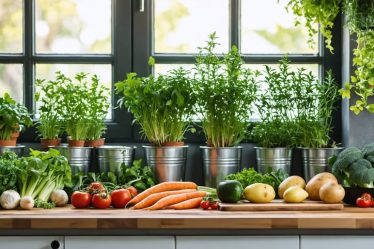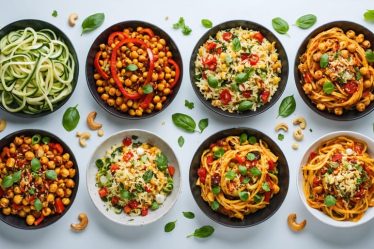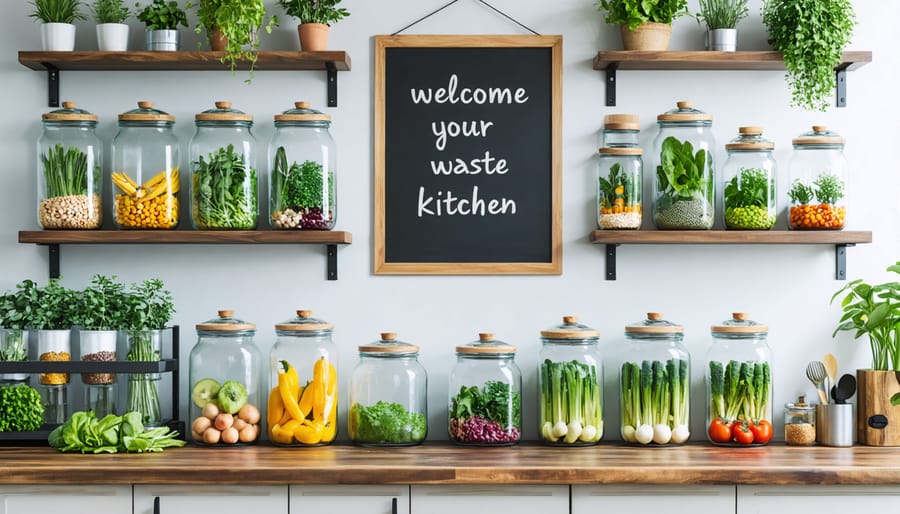
Transform your kitchen into a zero-waste sanctuary by replacing single-use plastics with glass jars, reusable produce bags, and bulk storage containers. Master the art of creating healthy homemade meals from kitchen scraps, turning vegetable ends into flavorful broths and fruit peels into natural cleaning solutions. Your journey to a waste-free lifestyle starts with small, intentional choices that create lasting impact.
Picture this: A kitchen where every item serves multiple purposes, where food waste transforms into garden gold through composting, and where shopping trips involve beautiful mason jars instead of plastic bags. This isn’t just an Instagram-worthy aesthetic – it’s a practical approach to modern living that saves money while protecting our planet.
The zero-waste movement isn’t about perfection; it’s about progress. Whether you’re a busy parent, a young professional, or someone simply looking to make a difference, reducing waste doesn’t mean compromising on convenience or style. By embracing simple swaps and mindful habits, you’ll discover that living with less waste actually means living with more – more creativity, more connection to your food, and more satisfaction in knowing that your daily choices matter.
Ready to revolutionize your relationship with waste? Let’s explore how small changes in your kitchen can create ripples of positive change in your life and our environment.
Smart Shopping: The Foundation of a Zero-Waste Kitchen
Reusable Shopping Essentials
When I first started my zero-waste journey, I quickly learned that having the right reusable shopping essentials was like having a trusty toolkit for sustainable living. The foundation of waste-free shopping starts with a collection of sturdy cloth bags – I keep a few larger ones for general groceries and smaller ones for bulk items like nuts and grains. Pro tip: stash them by your front door or in your car to ensure you never forget them!
Mesh produce bags have been absolute game-changers for my fruit and vegetable shopping. They’re lightweight, washable, and allow cashiers to easily see what’s inside. I especially love how they keep my produce fresh longer than plastic bags ever did.
Glass jars and containers are another must-have in my zero-waste arsenal. I use them for everything from buying loose ingredients at bulk stores to storing leftovers. Before heading to the store, I simply get my containers weighed at the customer service desk (they’ll mark the tare weight), making checkout a breeze. While the initial investment in these reusables might seem higher than disposable alternatives, they’ve saved me money in the long run and helped create a more sustainable shopping routine.
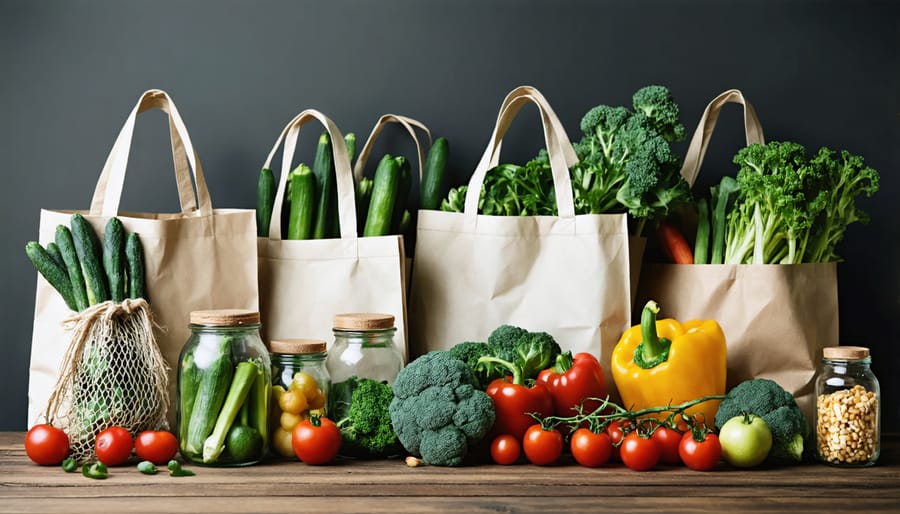
Bulk Shopping Strategies
Embracing bulk shopping is a game-changer for anyone committed to a zero-waste lifestyle, and with the right strategies, it can be both cost-effective and environmentally friendly. Think of it as your personal contribution to reducing packaging waste while saving money – a win-win situation that aligns perfectly with modern smart kitchen solutions.
Start by assembling your zero-waste shopping kit: bring along reusable cloth bags, glass jars, or containers with their tare weights noted. Many bulk stores will happily weigh your containers before filling, ensuring you only pay for the product itself. I remember feeling a bit awkward the first time I brought my own containers, but the staff was incredibly supportive, and now it’s second nature!
When shopping, focus on items with long shelf lives that you regularly use. Think dried beans, grains, nuts, and spices. Start small and gradually expand your bulk-buying repertoire as you become more comfortable with the process. Keep a running inventory of what you have at home to avoid overbuying – something I learned the hard way with quinoa!
Don’t forget to check if your local farmers’ market or grocery store has a bulk section. You might be surprised to find options beyond the specialty zero-waste shops. Many conventional stores are expanding their bulk offerings in response to growing environmental awareness.
Remember to label your containers with purchase dates and storage instructions. Consider creating a dedicated space in your pantry for bulk items, making it easier to see when supplies run low. This organization system helps maintain freshness and prevents food waste, another essential aspect of zero-waste living.
Food Storage Solutions That Extend Freshness
Plastic-Free Storage Options
Making the switch to plastic-free storage isn’t just better for the environment – it can actually transform your kitchen experience into something more beautiful and intentional. I remember how overwhelmed I felt when first replacing my plastic containers, but trust me, the transition is worth it!
Glass jars have become my absolute favorites for storing everything from grains to leftovers. They’re perfect for seeing what’s inside, they don’t absorb odors, and they last practically forever. I love repurposing pasta sauce jars, but you can also invest in matching mason jars for a more cohesive look.
Silicone storage bags are game-changers for replacing disposable zip-locks. They’re incredibly versatile – use them for snacks, freezer storage, or even sous vide cooking. While the upfront cost might seem high, they quickly pay for themselves.
Don’t overlook the power of simple cloth alternatives! Cotton produce bags are perfect for storing fruits and vegetables, while beeswax wraps make excellent replacements for plastic wrap. I keep a drawer full of various sizes of both, and they’ve completely eliminated my need for disposable options.
For bulk ingredients, consider investing in airtight glass or stainless steel canisters. They look stunning on open shelving and keep your pantry staples fresh. Plus, they make it super easy to see when you’re running low on ingredients.
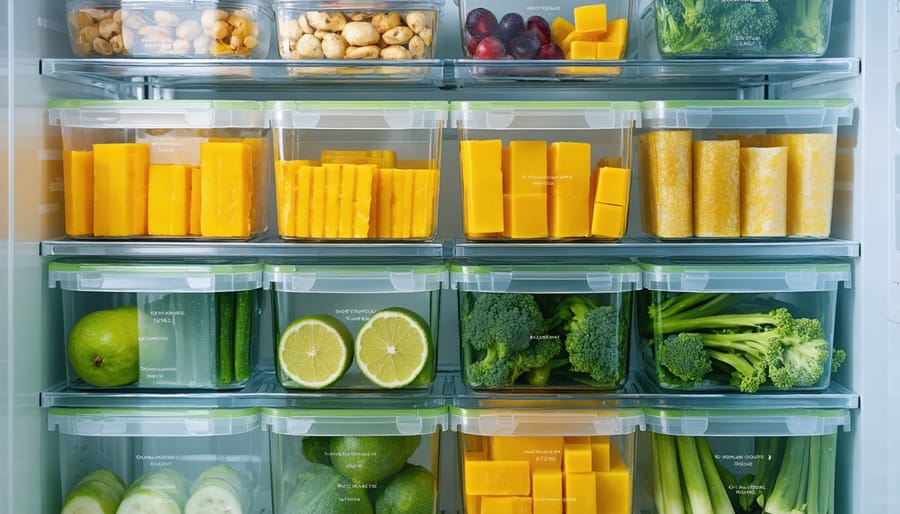
Food Preservation Techniques
I remember when I first started my zero-waste journey, discovering traditional food preservation methods felt like unlocking my grandmother’s secret wisdom. The good news is, keeping food fresh without plastic isn’t just possible – it’s actually quite simple and often more effective!
Let’s start with the basics: root vegetables like potatoes, onions, and garlic stay fresh longest in cool, dark places stored in cotton bags or paper. For leafy greens, try the tea towel method: wrap them in a slightly damp cloth and store them in your crisper drawer. They’ll stay crisp for up to two weeks!
Fermentation is another game-changer. Making your own sauerkraut, kimchi, or pickled vegetables not only preserves food naturally but also creates beneficial probiotics. All you need is salt, vegetables, and glass jars. I was amazed at how my first batch of fermented carrots lasted for months!
Dehydrating fruits and vegetables is perfect for preserving seasonal abundance. You don’t need fancy equipment – an oven on its lowest setting works well. Dried apple rings and tomatoes are particular favorites in my household, especially for winter snacking.
For herbs, try the hang-drying method. Bundle them with twine and hang upside down in a well-ventilated area. Once dried, store them in glass jars. You can also freeze herbs in olive oil using ice cube trays – perfect for adding instant flavor to winter soups.
Remember, the key to successful food preservation is starting with fresh ingredients and clean containers. These methods not only reduce waste but also help you save money while connecting with traditional food preservation wisdom.
Creative Cooking to Use Everything
Scraps to Stock
Transform your kitchen scraps into liquid gold with this sustainable approach to homemade vegetable stock. As part of developing mindful cooking habits, I started keeping a “stock bag” in my freezer, and it’s been a game-changer for both my wallet and the planet.
Start by collecting vegetable trimmings that you’d normally toss: onion skins, carrot tops, celery leaves, mushroom stems, herb stalks, and garlic paper. Store these treasures in a freezer-safe container or bag until you have enough to make stock (about 4-6 cups of scraps). Just remember to wash your vegetables well before storing the trimmings, and avoid anything moldy or spoiled.
When you’re ready to make your stock, simply place your frozen scraps in a large pot, cover with water, and add a bay leaf and peppercorns if desired. Bring to a boil, then reduce heat and simmer for about an hour. Strain the liquid, and voilà – you’ve created a flavorful base for soups, risottos, and sauces without spending an extra penny.
Pro tip: Keep a separate bag for onion skins and garlic papers – they add wonderful color and depth to your stock. Also, avoid using strong-flavored vegetables like cabbage or Brussels sprouts, which can overpower the stock’s taste. Store your homemade stock in glass jars in the freezer (leaving room for expansion) for up to three months.
This simple practice not only reduces food waste but also ensures you always have fresh, preservative-free stock on hand for cooking.
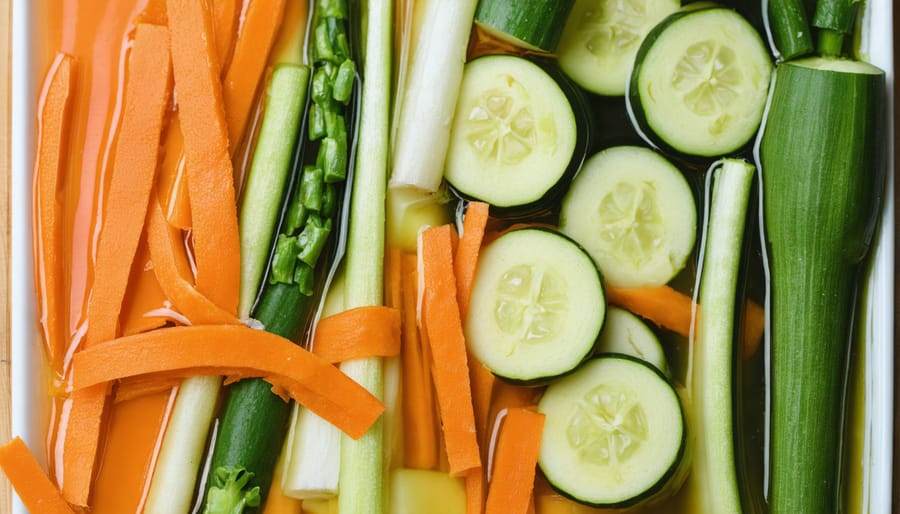
Beyond Peels and Stems
Remember those carrot tops and potato peels you usually toss in the trash? They’re actually kitchen treasures in disguise! I used to be guilty of throwing away these perfectly good produce parts until I discovered how versatile they can be.
Let’s start with those leafy carrot tops – they make an amazing pesto when blended with olive oil, garlic, and nuts. Potato peels? Toss them with olive oil and seasonings, then bake until crispy for a zero-waste snack that rivals store-bought chips. Even those broccoli stems that often get left behind can be transformed into delicious slaw or added to stir-fries for extra crunch.
One of my favorite discoveries was learning that citrus peels can be candied for sweet treats or infused in vinegar to create natural cleaning solutions. And those onion skins? They’re packed with natural dyes perfect for Easter eggs or fabric projects, plus they add rich color to homemade stocks.
Watermelon rinds might seem destined for the compost bin, but they can be pickled for a tangy treat that’s popular in Southern cuisine. Even apple cores and strawberry tops can find new life in flavored water or homemade vinegar.
The best part? These creative uses not only reduce waste but also stretch your grocery budget further. Plus, many of these often-discarded parts are actually nutrient powerhouses. Start small by experimenting with one or two ideas, and you’ll be amazed at how quickly these waste-reducing habits become second nature in your kitchen routine.
Composting Made Simple
When I first started composting in my tiny apartment, I thought I was in way over my head. But trust me, whether you’re living in a cozy studio or have a sprawling backyard, composting can easily become part of your daily routine.
For apartment dwellers, counter-top composting bins are your new best friend. These compact containers, often with charcoal filters, keep odors at bay while collecting your kitchen scraps. I keep mine under the sink, tossing in coffee grounds, fruit peels, and vegetable trimmings throughout the week. Many cities now offer community composting programs where you can drop off your collected scraps, or you might find a neighbor with a garden who’d love your organic waste.
If you’re blessed with outdoor space, you’ve got even more options. Start with a simple pile in a corner of your yard, or invest in a tumbling composter for faster results. The key is maintaining the right balance of “greens” (food scraps, grass clippings) and “browns” (dry leaves, paper, cardboard). Think of it as a lasagna – layer your materials, and nature does the rest.
Remember these composting basics:
– Add egg shells, coffee grounds, fruit and vegetable scraps
– Skip meat, dairy, and oily foods
– Keep things moist but not wet
– Give it a stir every few days
The reward? Rich, dark compost that your plants will love, and the satisfaction of keeping valuable nutrients out of landfills. Plus, there’s something magical about turning what would have been trash into garden gold.
Embarking on a zero-waste journey doesn’t mean you have to transform your entire lifestyle overnight. Remember, every small step counts towards creating a more sustainable future. Start with simple swaps like bringing your own shopping bags or choosing package-free produce. As you become more comfortable with these changes, you can gradually incorporate more zero-waste practices into your daily routine.
What’s beautiful about this lifestyle is that it’s not about perfection – it’s about progress. I started my journey by simply refusing plastic straws, and today, my household waste has reduced by over 70%. The key is to be patient with yourself and celebrate the small victories along the way.
Whether you’re motivated by environmental concerns, saving money, or simply wanting to live more intentionally, remember that your individual actions matter. Join local zero-waste communities, share your experiences, and learn from others who are on the same path. Together, we can create meaningful change, one reusable container at a time.
Start today with just one change – you might be surprised at how naturally the rest follows.

